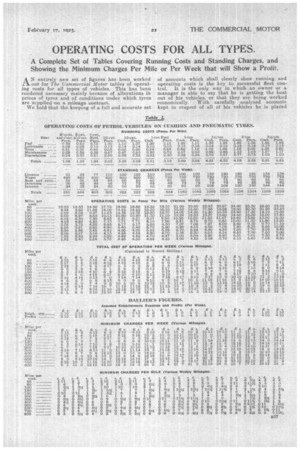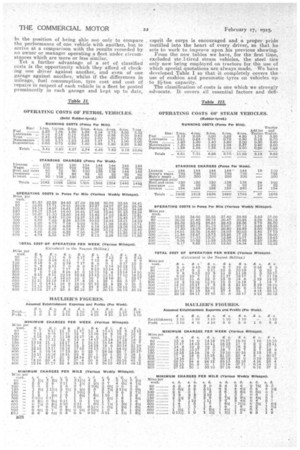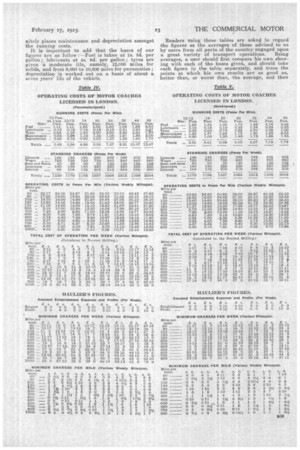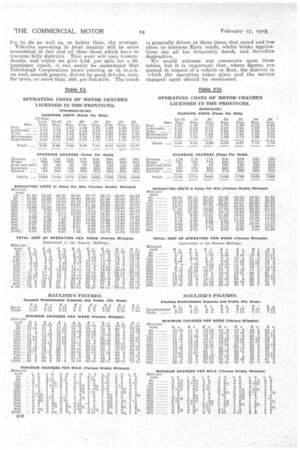OPERATING. COSTS FOR ALL TYPES.
Page 21

Page 22

Page 23

Page 24

If you've noticed an error in this article please click here to report it so we can fix it.
A Complete Set of Tables Covering Running Costs and Standing Charges, and Showing the Minimum Charges Per Mile or Per Week that will Show a Profit.
AN entirely new set of figures has been worked out for The Commercial Motor tables of operating costs for all types of vehicles. This has been rendered necessary mainly because of alterations in prices of tyres and of conditions under which tyres are supplied •on a mileap contract.
We hold that the keeping of a full and accurate set
of accounts which shall clearly show running and operatingcosts is the key to successful fleet control. It is the only way in which an owner or a manager is able to say that he is getting the best out of his yehicLes, or that they are being worked economically. With carefully analysed accounts kept in respect of all of his vehicles he is placed in the position of being able not only to compare the performance of one vehicle. With another; but to arrive at a comparison with the results recorded by an owner or manager operating a fleet under circumstances which are more or less similar.
' Yeta further advantage of a set of classified costs is the opportunity which they afford of checking one driver 'against another, and even of one . garage against another, whilst if the differences in mileage, fuel consumption, tyre cost and cost, of repairs in respect of each vehicle in a fleet be posted prominently in each garage and kept up to date,
, esprit de corps is encouraged and a proper pride instilled into the heart of every driver, so that he sets to work to improve upon his previous showing. From the new tables we have, for the first time, excluded ste ,l-tired steam vehicles, the steel tire only now being employed on tractors for the use of which special quotations are always made. We 'have developed Table I so that it completely covers the • use of cushion and pneumatic tyres on vehicles up to 2i-ton capacity.
The classification of-costs is one which we strongly advocate. It covers all essential factors and defi
nitely places maintenance and depreciation amongst the running costs. It is important to add that the bases of our figures are as follow :-Fuel is taken at Is. 3d. per gallon; lubricants at 4s. 6d. per gallon ; tyres are given a, moderate life, namely, 12,000 miles for solids, and from 9,000 to 10,000 miles for pneumatics; depreciation is worked out on a basis of about a seven years' life of the vehicle.
Readers using these tables are asked to regard the figures as the averages of those advised to us by users from all parts of the country engaged upon
a great variety of transport operations. Being averages, a user should first compare his -own showing with each of the bases given, and should take each figure in the table separately, and trace the points at which his own results are as good as, better than, or worse than, the average, and then
try to do as well as, or better than, the average. Vehicles operating in level country will lie more economical in fuel and oil than those which have to traverse hilly districts. Tyre wear will vary tremendously, and whilst we give 3.8d. per mile for a 32passenger coach, it can easily be understood that Edinburgh Corporation buses running at 81 m.p.h. on cool, smooth granite, driven by good drivers, cost, for tyres, no more than .48d, per bus-mile. The coach is generally driven at three times that speed and has often to traverse flinty roads, whilst brake applications are all too frequently harsh, and therefore destructive.
We would welcome any comments upon these tables, but it is important that, where figures are quoted in respect of a vehicle or fleet, the district in which the operation takes place and the service engaged upon should be mentioned.
































